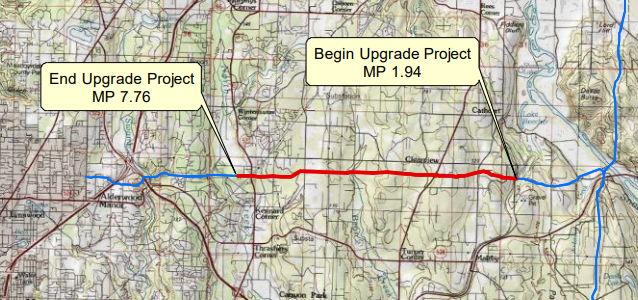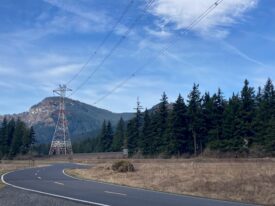The slow-motion battle expanding a six-mile pipeline in suburban Seattle might seem like small potatoes, but it’s Exhibit A in the fracked gas industry’s new playbook. Rather than roll out mega-project proposals sure to garner coordinated opposition, the gas industry now favors smaller, piecemeal projects that can avoid critical review. The western Washington gas utility Puget Sound Energy (PSE) is notoriously effective at deploying this strategy, from its heel-dragging on replacing coal-fired power to its support for building a new LNG facility in Tacoma. Now, the same tactics are on display in Snohomish County, Washington.
In July 2017, PSE and pipeline company Williams began the permitting process for a $47 million gas pipeline project in the Seattle area. The so-called North Seattle Lateral Upgrade would replace about six miles of pipeline in south Snohomish County, running from the Snohomish River north of Maltby, west to Alderwood. While the pipeline may be due for a replacement—a 2012 inspection found cracking and a leak in the 62-year-old pipe—Williams is using it as an opportunity to massively expand its capacity, replacing the existing 8-inch-diameter pipeline with a new one that’s 20 inches wide.
The new pipeline would generate 3.8 million metric tons of carbon dioxide-equivalent emission—that’s more than the entire city of Seattle.
If used at capacity, the new, bigger pipeline would lead to a major uptick in regional greenhouse gas pollution. In fact, the US Federal Energy Regulatory Commission (FERC) determined that using the gas carried by the new pipeline would generate 3.8 million metric tons of carbon dioxide-equivalent emission—that’s more than the entire city of Seattle—representing roughly a 5 percent increase in Washington’s carbon pollution. In spite of the climate impacts, FERC’s initial environmental assessment ignored pollution from fracking, transporting, and burning the gas. Using the report as its guide, Snohomish County issued a determination of non-significance—basically, a declaration that a project won’t substantially harm the environment—in October. That move opened the door to the final stages: permitting and building the project.

Map of North Seattle Lateral Pipeline Upgrade Map of North Seattle Lateral Pipeline Upgrade by Snohomish County
But the serious environmental impacts were not lost on local residents and grassroots environmental groups that called on the county and state to conduct a more thorough environmental review before granting permits to build. They pointed to potentially harmful consequences for wildlife, as well as raised safety concerns, particularly in light of the September 2018 gas pipeline explosions that killed an 18-year-old and injured dozens in Massachusetts.
That community pressure (and planners’ realization that a related storage facility would sit near a shifting river channel) caused Snohomish County to withdraw its determination of non-significance. The county went back to Williams and PSE, directing them to conduct an analysis of the impacts of the expansion project, including an evaluation of the climate impacts both “upstream” and “downstream” of the pipeline segment itself.
READ MORE: Studying ‘Upstream’ and ‘Downstream’ Effects of Methane Critical to PNW Climate Policy
The county called on Williams and PSE to calculate the increase in natural gas use that would result from the pipeline expansion and to “identify whether the project will require additional production or extraction of natural gas to serve the increased capacity.”
In other words, Williams says the additional gas would come from nowhere and be burned by no one.
In its response, Williams essentially ignored the county’s direction and submitted a self-contradictory argument seemingly to avoid actually accounting for increased carbon emissions. According to Williams, the new larger pipeline is designed to deliver larger volumes of fracked gas during periods of peak demand by PSE’s utility customers, and yet this additional gas would increase neither extraction of gas nor its combustion. In other words, the additional gas would come from nowhere and be burned by no one.
Disappointingly, the county bought this dubious argument and re-issued its determination of non-significance on March 6, though regulators did append a milquetoast condition that Williams adopts the EPA Natural Gas STAR Methane Challenge Program for operating and maintaining the pipeline. The only requirements are to have a plan to limit emissions and submit some form of data on progress. There are no penalties or consequences for failing to meet certain targets and PSE is already a member, so it’s unclear if this even counts as an additional requirement.
The county’s decision spurred more than a thousand comments from concerned residents. Meanwhile, the Washington Department of Ecology denied a key water quality permit for the project, citing a lack of an approved mitigation plan for pollution of state waters. Williams is appealing that permit denial and the Department of Ecology is soliciting public comments on the project impacts through April 1.
If Williams does secure the water quality permit, the next hurdle will be the state Department of Fish and Wildlife, which is also responsible for issuing some permits. And even if permits are eventually granted, Williams’ intended start of construction—-early summer 2019—will likely be delayed because FERC’s Environmental Assessment is predicated on mitigating environmental damage by only allowing construction during the drier summer months.
Williams is appealing that permit denial and the Department of Ecology is soliciting public comments on the project impacts through April 1.
The North Seattle Lateral Pipeline is not a giant. It is not, by itself, the biggest impediment to Northwest’s clean energy future. Yet it is worth watching closely because projects like this are taken right out of the fracked gas industry’s new playbook: piecemeal but persistent growth that could “lock in” carbon emissions for decades to come.
The next generation of fossil fuel fights in Cascadia will likely not be waged over mega-projects—the industry has probably ceded that ground already—but over dozens of seemingly small-scale projects that together add up to a monstrosity. The North Seattle Lateral project is just the latest battlefield.









Pennie O'Grady
I’m curious if the gas pipe being expanded along N 80th right now is part of this or a similar project?
Thanks for reporting!
Jeanine SanClemente
The NSLP project runs east-west just south of 180th street. It begins near Burgermaster on the Bothell Everett Highway, crosses 35th Avenue and Highway 9 and ends near Fritch Mill. Construction is slated to start this summer.
Brian Terry
Seeing as this 20″ section is tied in on both ends with 8″, it will serve simply as a reservoir for additional volume to reduce pressure drop and possible outages during high demand times, in that specific area, during unusual cold weather. This does not, in any way, increase the load on the line. That will only increase with additional building and/or expanding of homes & businesses connected to the line. I find it comical that the line is being questioned and postponed while the old line is continuously leaking methane into the environment. Also, explosions are typically caused by old lines, like this one, and keeping this line active during this delay is dangerous to say the very least.
Eric de Place
PSE has specifically said that they want the expansion in order to deliver more gas to more customers, so it’s very much an enlargement of gas capacity (and fracking and combustion). To respond to some of your other points:
* there are plenty of ways to make a gas line safer without also building out a 63 percent increase of a segment.
* yes, this is only one segment in a much larger system, which is exactly the point of this article. The gas industry is intentionally pursuing a piecemeal segment by segment strategy so that any individual project looks small. In the aggregate, however, the system is growing inexorably.
* every serious look at decarbonization indicates that buildings will need to transition from gas to electricity for space conditioning. as much, the Northwest’s aim should be selectively decommissioning gas infrastructure, not enlarging it.
Don
I’m curious. Isn’t this pipeline designed to serve current and future homes and businesses that are anticipated as part of the Comprehensive Plan of Snohomish County? Isn’t it State policy to focus population and job growth in the built-up urban areas? Are you suggesting it’s good public policy to send that growth to rural areas?
Eric de Place
Don, your question is obviously not a serious one, but I’ll answer it anyway. We are suggesting nothing about comprehensive planning or urban growth patterns. We are, however, making the argument that expanding fossil fuel infrastructure is a bad idea.
Any credible plan to decarbonize the regional economy will mean converting residential heating and cooling from gas (and oil) to clean electricity. And the best way to do that is to stop building out new capital infrastructure—and expanding existing infrastructure—that would be in service for decades to come.
DON STARK
Actually, my question is serious. As you well know, the history and present of electricity is anything but “clean.” The process to achieve clean electricity is lengthy and costly (and a long-term legitimate goal). And your advocacy of constricting the availability of fossil fuels is also legitimate, but not without consequences. Under your proposed regime and its attendant energy price differentials, the ability to get new hook-ups to for natural gas will create incentives to build homes and jobs “somewhere” else.
I believe you should be willing to explore some of those consequences.
Eric de Place
Sorry, no. Washington’s electric grid is remarkably clean already and it’s getting cleaner with every passing day. That’s definitely true for the relevant service territory here: SnoPUD and even for PSE’s electric customers. There are well-understood and clearly defined pathways for transitioning the entire region’s electricity sector to nearly 100% carbon free over the next few decades, even while increasing the load on the system.
The “attendant price differentials” of not allowing new gas hookups would be… minuscule. And would likely have zero impact on urban development patterns.
Buster
there is no such thing has clean electricity. Its a figment of imagination. Natural Gas is really the “cleanest” of all products.